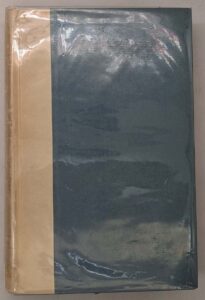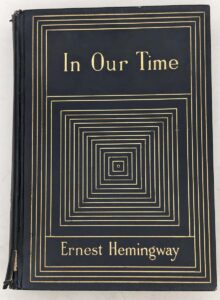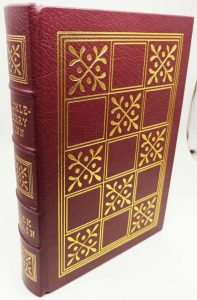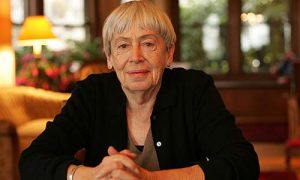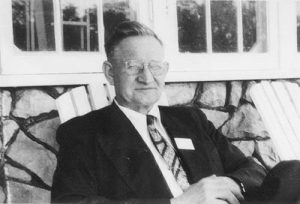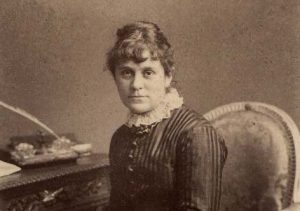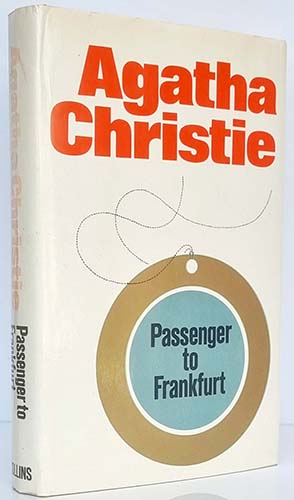
Passenger to Frankfurt: An Extravaganza is a spy novel by Agatha Christie first published in the United Kingdom by the Collins Crime Club in September 1970 and in the United States by Dodd, Mead and Company later in the same year. The UK edition retailed at twenty-five shillings. In preparation for decimalisation on 15 February 1971, it was concurrently priced on the dustjacket at £1.25. The US edition retailed at $5.95.
It was published to mark Christie’s eightieth birthday and, by counting up both UK and US short-story collections to reach the desired total, was also advertised as her eightieth book. It is the last of her spy novels. At the beginning of the book there is a quote by Jan Smuts, “Leadership, besides being a great creative force, can be diabolical …”
Sir Stafford Nye, a middle-aged diplomat, steps into the world of spies, double agents, and secret groups to effect a change in international power centres. He meets a woman who has selected him to aid her at a crucial point, when a weather delay changes where her and his aeroplane flight lands before proceeding to England. There is much commentary on the changes in the world, especially college age youth in Europe, the United States, and South America, in the late 1960s.
It is one of only four Christie novels not to have received an adaptation of any kind, the others being Death Comes as the End, Destination Unknown and Postern of Fate.
Plot Summary
[SPOILER ALERT]
Sir Stafford Nye’s flight home from Malaya takes an unexpected twist, when a woman approaches him in the Frankfurt Airport. The woman claims that her life is in danger, and that she needs his help. Nye agrees to lend her his travelling cloak, passport, and boarding ticket. A colleague in London, Horsham of Security, tells Nye that his action in Frankfurt saved Mary Ann’s life; Sir Stafford heard another name announced for her at the airport, Daphne Theodofanous. Nye has dinner with his friend Eric, worried for his professional reputation. Mary Ann returns his passport, taped into a magazine in his post. Nye advertises in the personals section of the newspaper for his mystery woman, signing himself as Passenger to Frankfurt. She replies with tickets to an opera, given at a discreet meeting on a bridge. His great-aunt Matilda hints to him of a terrible world-wide conspiracy, which uses a phrase of music from Richard Wagner, related to the opera Siegfried (1876). Matilda detects that he has a woman in his life now.
The opera is Siegfried, part of The Ring of the Nibelung by Wagner. The mystery woman attends only the second half, leaving Nye the tune for young Siegfried marked on a copy of the program, a motif for what she is doing. He attends an embassy party, given by the American ambassador and his wife, Sam and Mildred Cortman. Mary Ann is there, under her real name, Countess Renata Zerkowski. She offers Nye a ride home, but takes him instead to the home of Mr Robinson the financier, where they meet Colonel Pikeaway, Lord Altamount, James Kleek and Horsham. Nye is not seen for a while, as he has been accepted by the close-knit group of British intelligence to aid in accomplishing the tasks Mary Ann has taken on. They travel extensively. Mary Ann warns Nye that one among their own group is probably a traitor.
Some believe that near the end of World War II, Adolf Hitler went to a mental institution, met with a group of people who thought they were Hitler, and exchanged places with one of them, thus surviving the war. He escaped to Argentina, where he married and had a son who was branded with a swastika on his heel. This belief encourages those who want to resurrect the beliefs and ways of the Nazis. The Countess believes she has this boy with his swastika tattoo. The story is told to the Intelligence group by psychiatrist Dr Reichardt, but they know it is false. Hitler had no son. The British Intelligence group explains in several long expository chapters how drugs, promiscuity, and student unrest in the United States and Europe are caused by Nazi agitators. The agitators begin to bring about anarchy, attacking the American ambassador and the French Marshal. The goal is to re-build fascism. Meetings in Paris and London describe the movement of money and arms and their sources, and major players.
Nye’s great-aunt, Lady Matilda, goes on her own trip, to visit her school mate, Countess Charlotte von Waldsausen, learning Charlotte’s plans to be leader of the fascist world, which she then relates to her nephew. On her return, Matilda tells her friend Admiral Philip Blunt about the scientist Professor Shoreham, who invented something called Project B, or Benvo, which is a drug that makes people altruistic, but may cause a long-term change. Shoreham had a stroke, and he cannot communicate well. He had shelved Project B before his stroke. The Intelligence group meets at Shoreham’s home, where he explains the limitations of his benevolent project. Kleek, traitor in the Intelligence group tries to kill Lord Altamount by poison and is blocked, so Miss Ellis the nurse to Shoreham shoots Lord Altamount, who dies of shock. Miss Ellis is recognized as Milly Jean Cortman, who had also killed her husband. The violent incident brings new energy to Shoreham, who resolves to restart work on his project. He will contact his colleague Gottlieb to restart Project Benvo and also arrange a memorial to Lord Altamount, the only politician he had ever trusted.
The final chapter is an epilogue, with Nye at Matilda’s house preparing for his upcoming marriage to Mary Ann. The supposed son of Hitler has been brought to England for a more normal life and is about to become the organist at their church. Sybil, Nye’s 5-year-old niece, will be the flower girl at the wedding. Nye forgets a best man, but asks Sybil to bring the panda, which he bought for her at the Frankfurt airport, as it has been “in it” from the beginning.
The final chapter is an epilogue, with Nye at Matilda’s house preparing for his upcoming marriage to Mary Ann. The supposed son of Hitler has been brought to England for a more normal life and is about to become the organist at their church. Sybil, Nye’s 5-year-old niece, will be the flower girl at the wedding. Nye forgets a best man, but asks Sybil to bring the panda, which he bought for her at the Frankfurt airport, as it has been “in it” from the beginning.
Publication history
- 1970, Collins Crime Club (London), September 1970, Hardcover, 256 pp
- 1970, Dodd Mead and Company (New York), Hardcover, 272 pp
- 1972, Pocket Books (New York), Paperback
- 1973, Fontana Books (Imprint of HarperCollins), Paperback, 192 pp
The International Standard Book Number (ISBN) system was introduced in 1970 by the International Standards Organization (ISO), and this is the first Agatha Christie novel to have an ISBN on the first edition. Re-issues published in 1970 or later of her earlier novels have the ISBN issued and appears on the book, but not the first editions of those novels.
Passenger to Frankfurt – First Edition Book Identification Guide
The books are listed in the order of publication. While the majority of Agatha Christie’s books were first published in the UK. There are many titles that were first published in the US. The title of the book may differs from the UK edition in some cases.
| Year | Title | Publisher | First edition/printing identification points |
|---|---|---|---|
| 1970 | Passenger to Frankfurt | William Collins & Sons, London, [1970] | First edition. "© Agatha Christie, Ltd., 1970" stated on the copyright page. No statement of later printings. Red cloth lettered in gold. Price £1.25/25s. |
| 1970 | Passenger to Frankfurt | Dodd, Mead & Co, NY, [1970] | First American edition. "© Agatha Christie, Ltd., 1970" stated on the copyright page. Burgundy boards, purple cloth spine lettered in gold. Price $ 5.95. |
Note about Book Club Editions (BCE) and reprints:
UK: You can see statements of later reprint dates or of book club on the copyright page.
US: The US reprint publishers usually use the same sheets as the first edition and are harder to identify by looking at the title page or the copyright page. One may identify a BCE by looking at the DJ, which doesn’t have a price on top of the front flap and a “Book Club Edition” imprint at the bottom. If the dust jacked is clipped at both the top/bottom of the front flap. You can safely assume it’s a BCE . If the book is missing the dust jacket. Later BCE editions can be identified by its plain boards, while first printings are issued in quarter cloth.
Please refer to the gallery for detailed images of true first edition bindings and dust jackets.
Passenger to Frankfurt – First Edition Dust Jacket Identification Guide
First edition bindings and various dust jacket printings identification.
